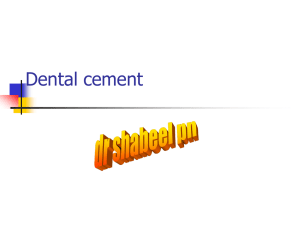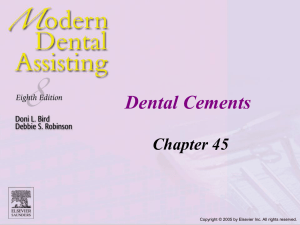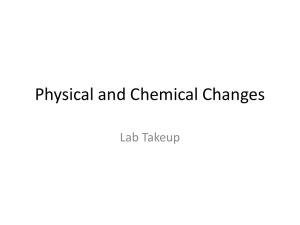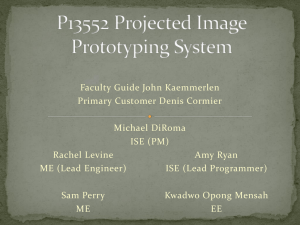Dental cements
advertisement
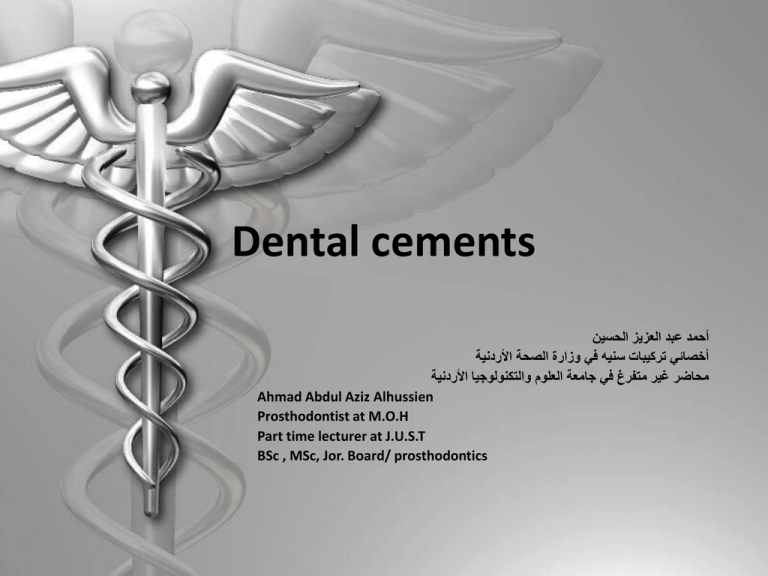
Dental cements أحمد عبد العزيز الحسين أخصائي تركيبات سنيه في وزارة الصحة األردنية محاضر غير متفرغ في جامعة العلوم والتكنولوجيا األردنية Ahmad Abdul Aziz Alhussien Prosthodontist at M.O.H Part time lecturer at J.U.S.T BSc , MSc, Jor. Board/ prosthodontics Uses of dental cements • Pulpal protection (liners, bases, varnishes) • Luting cementation (crowns, inlays, onlays veneers) • Restorations (temporary and permanent) • Surgical dressing (e.g. periodontal surgery) Cavity varnish • a thin layer placed on the floor and wall of the cavity to seal dentinal tubules and minimize microleakage. • Composition: – Natural resin (copal) – Synthetic resin dissolved in solvent such as alcohol or chloroform. Cavity varnish Application method: – The varnish is applied in a thin layer – The solvent evaporates within 5 –15 seconds – A second layer is applied The resin component protects pulp by: – Sealing dentinal tubules – Reducing microleakage – Reduce staining Dispensing and clinical considerations • 2 bottles: – Varnish: 90% solvent, 10% resin (copal) – Solvent to dilute varnish if solvent evaporates • The lid should be kept tightly closed • Varnishes have been largely replaced by bonding agents since varnishes wash out quickly Liners/low strength base Calcium hydroxide Clinical uses: – Liner to protect pulp – Direct and indirect pulp capping Dispensing: • 2 paste system “Self-cured” – Base: Calcium phosphate, calcium tungstate, Zinc oxide, Glycol salicylate – Catalyst: Calcium hydroxide, zinc oxide, zinc stearate in ethylene toluene sulfonamide • Light cured cement: UDMA + Ca hydroxide + barium sulfate filler and low viscosity monomer Liners/low strength base Calcium hydroxide • Set cement is calcium disalicylate • Properties: – Has an alkaline Ph 9-11(stimulates dentine formation) – Setting time: 2-7 minutes – Weak compressive strength – Thermal insulator – High solubility Liners/low strength base ZnO/Eugenol • Uses: – Pulpal protection in deep cavities • Properties: – Weak – Sedative effect – Little thermal insulation High strength base (>0.5mm) • Function: – Insulator – Support for restoration • Materials used: – GIC – Resin modified-GIC – Polymer reinforced ZnO/E • Properties required for high strength bases: – High strength that develop quickly – Low thermal conductivity – Moderate elastic modulus Luting cements • Desirable features: – Good wettability – Good flow – Thin film thickness: 25 µm or less to fill the space between tooth structure and restoration. Restorations • Permanent: cements are rarely used as restorations due to: – Low strength – Low wear resistance – High solubility • The exception is GIC, used for class V cavities and primary teeth. Zinc oxide eugenol temporary filling Dental cements ZnO cements Glass ionomer cements Resin cements Compomer cements Hybrid ionomers Zinc phosphate Zinc polycarboxylate Zinc oxide eugenol • Advantages: 1. Wide variety of uses 2. Sedative to the pulp 3. Easily manipulated • Disadvantages 1. Low strength 2. High solubility 3. Not used under composite resin Zinc oxide eugenol • Some are resin or EBA reinforced • New products are eugenol free “cavit” • Properties: – – – – – – Sedative effect on pulp and antibacterial Biocompatible .. irritant if in direct contact with pulp Eugenol interferes with setting of resin Moderate strength Retention is mechanical Water and temperature increase accelerate setting Zinc phosphate • Used to be used as a permanent luting agent • Composition: – Powder: zinc oxide – Liquid: phosphoric acid and water buffered by Al + Zn to slow setting • Setting reaction: 5-9 minutes, exothermic, controlled by incremental incorporation of powder into liquid. Cement is porous. Zinc phosphate • Properties – Initial acidity with pH of 4.2, becomes neutral after 48 hours. – Retentive by mechanical retention sandblasting of crowns or inlays – Similar strength to GIC, high CS, low tensile strength. – Low solubility once set – Fast setting – Moisture adversely affects cement Zinc phosphate • Manipulation • Powder is dispensed and divided into 4-6 portions • Liquid is dispensed according to manufacturer • Mixing is gradual at 15 seconds intervals for 60-120seconds • Large strokes over a large area Zinc polycarboxylate • Uses: – High strength base – Final cementation of indirect restorations • Composition: – Powder: zinc oxide – Liquid: polyacrylic acid • Properties: – – – – Lower compressive strength than other cements Mild acidity Higher viscosity when mixed but reasonable flow Liquid should not be dispensed before needed, to avoid water evaporation and viscosity – Retention is chemical and mechanical – To increase working time use a cold slab • Manipulation: powder liquid systems, 90% of powder added first then the rest is mixed with liquid to adjust consistency Glass ionomer cements Composition • Main components are: – Glass – Polyacid – Water – Tartaric acid • Different types and combinations of polyacid and glass create different versions of GIC • • o o o • Glass Three main components: Silica SiO2 Alumina Al2O3 Calcium fluoride CaF2 In addition to sodium and aluminium fluorides, and calcium or aluminum phosphates. • Components are fused at high temperatures, shock cooled then ground to a powder. Particle size depends on application Liquid • Liquid: co-polymers of polyacrylic acid and water • E.g. of copolymers used: • Acrylic acid and itaconic acid • Acrylic acid and maleic acid Viscosity of the liquid depends on molecular weight and polyacid concentration. Tartaric acid influences working ad setting time DISPENSING • 2 bottle system hand mixed: o Powder o Liquid • Anhydrous cement: powder (glass and freeze dried polyacid) and distilled water • Capsules (pre-measured powder and liquid) mixed using a triturator (mixer). Easy to use, GIC is directly dispensed into cavity, eliminate errors from manual mixing. Acid base reaction. Three overlapping steps: • Dissolution • Gelation • Hardening Glass ionomer cements Composition and reaction explained previously Uses: • low/high strength bases (in deep cavities use calcium hydroxide instead) • Luting agents • Core build up • Restorative material (e.g. class V) • Manipulation Resin modified-GIC Uses: • Permanent cementation of crowns and bridges • Core build up • Liners • Bonding of orthodontic brackets Resin modified-GIC Properties: • Fluoride release • Low solubility once set • Early low pH then increases • High fracture toughness but lower than resin cements • Problem of water sorption (contraindicated for all-ceramic restorations, may cause cracking due to expansion) • Manipulation: capsules, powder liquid systems Resin-based cements • They are modified composites … Microfill or microhybrid • Properties: – Insoluble and high wear resistant – Good esthetic under all-ceramic crowns – Bonded by etching and bonding, sandblasting of internal surface of restoration • Setting: – Chemical cure – Light cure – Dual cure: most versatile Compomer cements • Composition: – Powder: fluorosilicate glass, sodium fluoride, selfcured and light-cured initiators – Liquid: polymerized-methacrylate-carboxylic acid monomer, water, acrylate-phosphate monomer, diacrylate monomer • Properties: – – – – Fluoride release low solubility high bond strength high fracture toughness and strength





